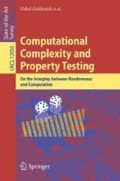Abstract
The standard models of testing graph properties postulate that the vertex-set consists of \(\{1,2,...,n\}\), where n is a natural number that is given explicitly to the tester. Here we suggest more flexible models by postulating that the tester is given access to samples the arbitrary vertex-set; that is, the vertex-set is arbitrary, and the tester is given access to a device that provides uniformly and independently distributed vertices. In addition, the tester may be (explicitly) given partial information regarding the vertex-set (e.g., an approximation of its size). The flexible models are more adequate for actual applications, and also facilitates the presentation of some theoretical results (e.g., reductions among property testing problems).
Access this chapter
Tax calculation will be finalised at checkout
Purchases are for personal use only
Notes
- 1.
- 2.
That is, if a graph \(G=(V,E)\) has the property, then, for any bijection \(\pi :V\rightarrow V'\), the graph \(G'=(V',\{\{\pi (u),\pi (v)\}:\{u,v\}\!\in \!E\}\) has the property.
- 3.
A more refined definition, following [3], may consider the number of queries to each of the oracles. In such a case, it makes sense to refer to the number of queries to the adjacency predicate (resp., the sampling device) as the query (resp., sample) complexity of the tester.
- 4.
For simplicity, we adopt the standard convention by which the neighbors of v appear in arbitrary order in the sequence \((g(v,1),...,g(v,\mathrm{deg}(v)))\), where \(\mathrm{deg}(v){\mathop {=}\limits ^\mathrm{def}}|\{j\in [d]:g(v,j)\ne \bot \}|\).
- 5.
In some cases (e.g. [4, Sec. 9.2.3]), these testers use an estimate of |V| in order to avoided pathological problems that arise when \(|V|<B{\mathop {=}\limits ^\mathrm{def}}O(1/\epsilon )\). But determining whether not \(|V|<B\) holds can be done by using \({\widetilde{O}}(1/\epsilon )\) samples of V, let alone that it actually suffices to distinguish between \(|V|<B\) and \(|V|\ge 2B\).
- 6.
The obvious procedure is to keep sampling till seeing, say, 100 pairwise collisions, and then outputting the square of the number of trials (divided by 200).
- 7.
In a previous version of this paper, we considered \(g_1:V\times [|V|-1]\rightarrow V\cup \{\bot \}\), where \(|V|-1\) served as a trivial degree bound. In retrospect, we feel that using such an upper bound is problematic, because it may allow the tester to determine the number of vertices in the graph (assuming that querying \(g_1\) on an input that is not in its domain results in a suitable indication). On the other hand, allowing an infinite representation of finite graphs is not problematic, because the representation is not used as a basis for the definition of the relative distance between graphs.
- 8.
References
Alon, N., Fischer, E., Krivelevich, M., Szegedy, M.: Efficient testing of large graphs. Combinatorica 20, 451–476 (2000)
Alon, N., Shapira, A.: A separation theorem in property testing. Combinatorica 28(3), 261–281 (2008)
Balcan, M., Blais, E., Blum, A., Yang, L.: Active property testing. In: 53rd FOCS, pp. 21–30 (2012)
Goldreich, O.: Introduction to Property Testing. Cambridge University Press, Cambridge (2017)
Goldreich, O.: Hierarchy theorems for testing properties in size-oblivious query complexity. Comput. Complex. 28(4), 709–747 (2019). https://doi.org/10.1007/s00037-019-00187-2
Goldreich, O.: Testing graphs in vertex-distribution-free models. In: 51st STOC, pp. 527–534 (2019)
Goldreich, O., Goldwasser, S., Ron, D.: Property testing and its connection to learning and approximation. J. ACM 45, 653–750 (1998)
Goldreich, O., Ron, D.: Property testing in bounded degree graphs. Algorithmica 32(2), 302–343 (2002)
Goldreich, O., Ron, D.: A sublinear bipartitness tester for bounded degree graphs. Combinatorica 19(3), 335–373 (1999)
Goldreich, O., Trevisan, L.: Three theorems regarding testing graph properties. Random Struct. Algorithms 23(1), 23–57 (2003)
Goldreich, O., Trevisan, L.: Errata to [10]. Manuscript, August 2005. http://www.wisdom.weizmann.ac.il/~oded/p_ttt.html
Kaufman, T., Krivelevich, M., Ron, D.: Tight bounds for testing bipartiteness in general graphs. SIAM J. Comput. 33(6), 1441–1483 (2004)
Parnas, M., Ron, D.: Testing the diameter of graphs. Random Struct. Algorithms 20(2), 165–183 (2002)
Rubinfeld, R., Sudan, M.: Robust characterization of polynomials with applications to program testing. SIAM J. Comput. 25(2), 252–271 (1996)
Author information
Authors and Affiliations
Corresponding author
Editor information
Editors and Affiliations
Rights and permissions
Copyright information
© 2020 Springer Nature Switzerland AG
About this chapter
Cite this chapter
Goldreich, O. (2020). Flexible Models for Testing Graph Properties. In: Goldreich, O. (eds) Computational Complexity and Property Testing. Lecture Notes in Computer Science(), vol 12050. Springer, Cham. https://doi.org/10.1007/978-3-030-43662-9_19
Download citation
DOI: https://doi.org/10.1007/978-3-030-43662-9_19
Published:
Publisher Name: Springer, Cham
Print ISBN: 978-3-030-43661-2
Online ISBN: 978-3-030-43662-9
eBook Packages: Computer ScienceComputer Science (R0)

